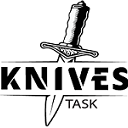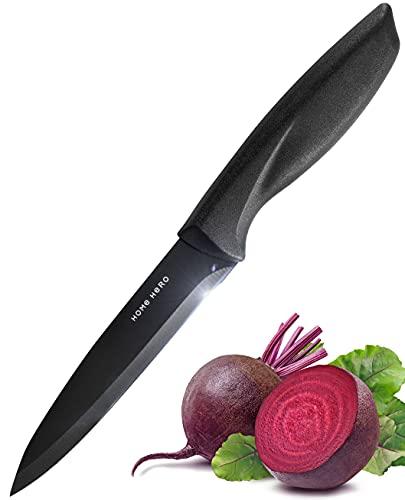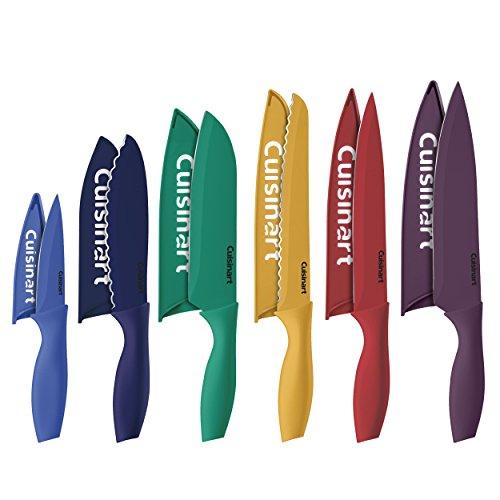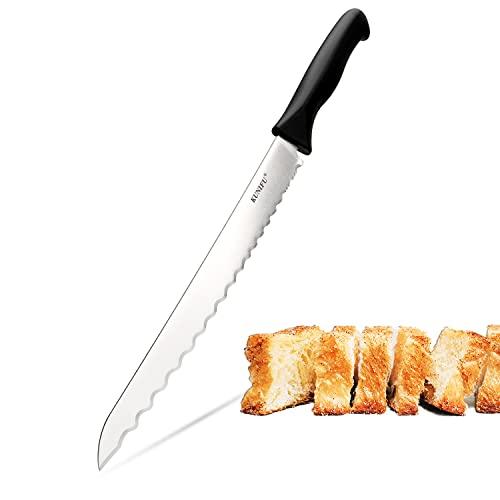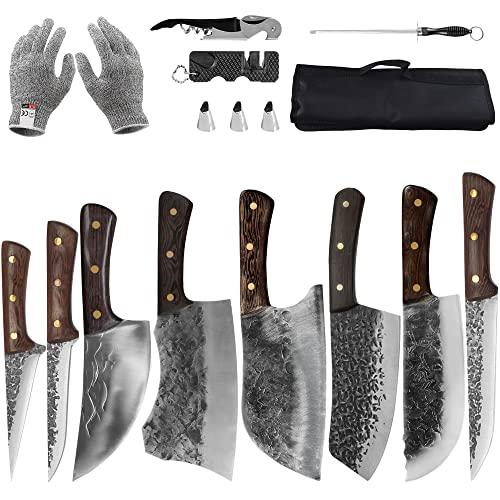A Santoku knife is a Japanese-style all-purpose kitchen knife. It is similar to a Western chef’s knife in that it has a broad, flat blade and can be used for a variety of tasks, including chopping, slicing, and mincing. Santoku knives typically have shorter blades than chef’s knives, which makes them more maneuverable and easier to control.
The name Santoku means “three virtues” or “three uses,” referring to the three main cutting tasks that this type of knife is designed for: slicing, dicing, and mincing.
A Santoku knife is a Japanese kitchen knife that is used for general purpose cutting. It can be used to chop vegetables, slice meat, and even fish. The Santoku knife is similar to a Western chef’s knife, but it has a few key differences.
First, the blade of a Santoku knife is typically shorter. Second, the edge of the Santoku knife is straight, not curved like a chef’s knife. Finally, the handle of a Santoku knife is usually ergonomically designed to fit comfortably in your hand.
So why would you choose a Santoku knife over a chef’sknife? Well, many people find that the shorter blade and straighter edge make it easier to control when chopping vegetables or slicing meat. Additionally, the ergonomic handle can help reduce fatigue when cutting food for extended periods of time.
Whether you’re a professional chef or just starting out in the kitchen, a Santoku knife can be a great addition to your toolkit!
What is a Santoku? – Master your Japanese knife!!
What is the Point of a Santoku Knife?
A Santoku knife is a type of all-purpose kitchen knife originating in Japan. Its name is derived from the Japanese words “santoku” (三徳), meaning “three virtues”, and refers to the three types of cuts that it is meant to excel at: slicing, dicing, and mincing.
The Santoku style of knife has become popular outside of Japan as well, particularly among Western home cooks who appreciate its versatility.
While most Santoku knives are made with stainless steel blades, some models feature a blade made out of carbon steel or even ceramic. The blade on a Santoku knife is generally shorter and thinner than that of a chef’s knife, making it better suited for precision work. The blade also has a flatter edge, which many find preferable for push-cutting rather than the rocker cutting motion used with a chef’s knife.
The handle on a Santoku knife is usually positioned lower on the blade than that of a chef’s knife, which gives the user more control over precise cuts. Additionally, the shape of the Santoku handle often tapers towards the end, making it more comfortable to grip for extended periods of time.
While not strictly necessary, many people find that using a Santoku knife can make meal preparation quicker and easier thanks to its versatile design.
Whether you’re chopping veggies for stir-fry or slicing meat for sandwiches, a good Santoku knife can help you get the job done quickly and efficiently.
Is Santoku Knife Good for Carving Meat?
A Santoku knife is a general-purpose kitchen knife that originated in Japan. The word Santoku means “three uses” or “three virtues”, referring to the three cutting tasks that this type of knife is best suited for: slicing, dicing, and mincing. Santoku knives are typically between five and seven inches long, with a blunt tip and a relatively wide blade.
This design makes them ideal for carving meat, as the wide blade can easily slice through thick cuts of steak or poultry.
While Santoku knives are not specifically designed for carving meat, they can be a good option if you don’t have a dedicated carving knife. Just keep in mind that the shorter length of most Santoku knives may make it difficult to carve large roasts or turkeys.
If you do decide to use a Santoku knife for carving meat, be sure to use a sawing motion rather than trying to chop through the meat with the blade.
Do Chefs Use Santoku Knives?
Santoku knives are a type of Japanese kitchen knife that have become popular in recent years. They are similar to Western chef’s knives in terms of their size and shape, but they often have a thinner blade and a more pointed tip. Santoku knives are used for slicing, dicing and mincing, and they can be used for both cooked and raw foods.
While they are not as common as chef’s knives in professional kitchens, many home cooks enjoy using them because of their versatility.
What is the Difference between the Shape of a Chef’S Knife Vs a Santoku Knife?
A chef’s knife and a Santoku knife may look similar at first glance, but there are actually some key differences between the two. For one, a chef’s knife is typically much longer than a Santoku knife. This makes it ideal for slicing through large pieces of meat or vegetables, while the shorter Santoku is better suited for smaller chopping tasks.
Another difference lies in the shape of the blade. A chef’s knife has a curved edge that tapers to a point, while a Santoku has a straight edge with a blunt tip. This gives the chef’s knife a more versatile cutting ability, as you can use the curve to rock back and forth when slicing through tough ingredients.
Meanwhile, the Santoku’s straighter blade is better suited for precision chopping.
Finally, another key distinction between these two knives is how they’re balanced. A chef’s knife is usually balanced closer to the handle, which gives you more control over precise cuts.
On the other hand, Santokus are often balanced closer to the blade end; this design makes them easier to maneuver quickly when chopping large quantities at once.

Credit: fnsharp.com
What is a Chef Knife Used for
A chef knife is a multipurpose kitchen tool that can be used for a variety of tasks, including chopping, slicing, and mincing. Whether you’re an experienced cook or just starting out, a chef knife is an essential piece of equipment to have in your kitchen. Here are some tips on how to use a chef knife like a pro:
Chopping: A chef knife is the perfect tool for chopping vegetables, fruits, and meats. To chop using a chef knife, hold the food item in one hand and grip the handle of the knife with the other. Then, use a sawing motion to chop through the food.
Be sure to keep your fingers away from the blade as you chop.
Slicing: A chef knife can also be used for slicing food items such as cheese and bread. To slice using a chef knife, hold the food item in one hand and grip the handle of the knife with the other.
Then, use a back-and-forth slicing motion to cut through the food. Be sure to keep your fingers away from the blade as you slice.
Mincing: Mincing is a technique often used in cooking to create small pieces of food that will cook evenly and quickly.
To mince using a chef knife, first chop the food item into large pieces. Then, grip the handle of the knife with one hand and hold down on the top of blade with your other hand (this will help keep your fingers safe). Use a rocking motion to move the blade back-and-forth acrossthe chopped pieces until they are minced into small pieces.
No matter what task you’re using it for, always exercise caution when handling a sharpknife like a chef’sknife!
What is a Utility Knife Used for
A utility knife is a multipurpose tool that can be used for a variety of tasks, including cutting through packaging, opening boxes, and slicing vegetables. Utility knives typically have a retractable blade that can be extended and retracted as needed. Some utility knives also have a built-in serrated edge for sawing through tougher materials.
Utility knives are an essential tool for any home or office. They’re versatile, durable, and easy to use, making them ideal for a wide range of applications. Whether you need to open a box or cut through packing material, a utility knife will get the job done quickly and easily.
Santoku Knife Vs Chef
When it comes to kitchen knives, there are a few different types that are essential for different tasks. Two of the most popular and versatile types of knives are the Santoku knife and the chef’s knife. Both can be used for a variety of chopping, slicing, and dicing tasks, but they have some key differences.
The Santoku knife is a Japanese-style knife that is shorter and lighter than a chef’s knife. It has a straighter edge and a thinner blade, which makes it great for precision cutting. The Santoku is also well-suited for slicing vegetables and meat because its straight edge creates nice, clean cuts.
The chef’s knife, on the other hand, is heavier and has a curved edge. This design allows for more Rockwell hardness along the edge of the blade, making it ideal for tougher chopping tasks like breaking down chicken breasts or slicing through thick cuts of meat. The curve also provides extra knuckle clearance when you’re doing chopped prep work on a cutting board.
Because of its weight and heft, many people find that the chef’s knife is less comfortable to use for extended periods of time than the Santoku.
So, which one should you choose? If you do a lot of vegetable prep work or need to make very precise cuts, then go with a Santoku knife.
If you do more heavy-duty chopping or want aknife that can handle tough meats with ease, then opt for a chef’s knife.
Santoku Knife Definition
Santoku knives are all-purpose Japanese kitchen knives that are great for slicing, dicing, and mincing. The word “santoku” means “three uses” in Japanese, referring to the three cutting tasks that these knives are designed for. Santoku knives typically have a shorter blade than Western-style chef’s knives, and they often have a granton edge – a series of scallops on the blade that prevent food from sticking to it.
If you’re looking for an all-purpose knife to add to your kitchen arsenal, a santoku knife is a great option. These versatile knives can handle just about any cutting task you throw at them, and they’re relatively easy to control thanks to their shorter blades. Whether you’re a beginner or a seasoned pro, you’ll appreciate the utility of having a santoku knife in your kitchen.
Santoku Knife Advantages
A Santoku knife is a Japanese-style all-purpose kitchen knife. It can be used for chopping, slicing, and mincing. The Santoku knife is similar to a chef’s knife, but it has a thinner blade and a straighter edge.
The word “Santoku” means “three virtues” or “three uses” in Japanese. These three uses are slicing, dicing, and mincing.
The Santoku knife was designed to be an all-purpose kitchen tool that could replace the many different knives that were traditionally used in Japanese cooking.
The Santoku knife has a shorter blade than a chef’s knife, which makes it easier to control when cutting vegetables or meat. The straight edge of the Santoku blade also makes it easier to chop food into uniform pieces.
The Santoku knife is made with high-carbon stainless steel or ceramic blades.
The steel blades are harder than the ceramic blades and will stay sharp longer, but they are more prone to rusting if not properly cared for. Ceramic blades do not rust and they are very hard, but they can chip if dropped on a hard surface.
The most important feature of any kitchen knife is the handle.
A comfortable handle will make chopping, slicing, and mincing much easier on your hands and wrists. Most Santoku knives have ergonomic handles that fit comfortably in your hand. Look for a Santoku knife with a riveted handle for added durability.
How to Choose a Santoku Knife
When it comes to choosing a Santoku knife, there are a few things you need to take into consideration. First, think about what size knife you need. Santoku knives come in a variety of sizes, so it’s important to choose one that will be comfortable for you to use.
Next, consider the blade material. Santoku knives are typically made from high-carbon steel or stainless steel. High-carbon steel blades are sharper and hold their edge longer than stainless steel blades, but they can be more difficult to sharpen and are more susceptible to rust and corrosion.
Stainless steel blades, on the other hand, are easier to sharpen and require less maintenance.
Finally, think about the handle material. Santoku knives can have handles made from wood, plastic, or metal.
Each materials has its own benefits and drawbacks, so it’s important to choose one that will fit your needs and preferences.
No matter what material you choose for your Santoku knife, make sure it feels comfortable in your hand and is the right size for your needs. With a little bit of research, you’re sure to find the perfect knife for your kitchen!
Best Santoku Knife
A Santoku knife is a Japanese-style all-purpose kitchen knife. It is similar to a chef’s knife in terms of shape and size, but it has a few key differences that make it ideal for certain tasks. For one, the Santoku features a sheepsfoot blade, which makes it great for slicing and dicing vegetables.
Additionally, the Santoku has a much thinner blade than a chef’s knife, which makes it ideal for precision cutting.
If you are looking for an all-purpose kitchen knife that can do it all, then the Santoku is the perfect option. It is versatile enough to handle any task you throw at it, yet still precise enough for delicate work.
Whether you are chopping vegetables or slicing meat, the Santoku will get the job done quickly and efficiently.
Santoku Knife Masterchef
A Santoku knife is a Japanese-style chef’s knife that is becoming increasingly popular in Western kitchens. The word Santoku means “three virtues” or “three uses” and refers to the three cutting tasks that this knife is ideally suited for: slicing, dicing, and mincing.
The Santoku has a shorter blade than a traditional chef’s knife, making it easier to control and maneuver.
The blade is also typically thinner than a Western chef’s knife, which makes it great for precision cutting. The edge of the Santoku is often slightly curved, which helps to rock the blade back and forth when chopping vegetables or other ingredients.
One of the most notable features of the Santoku is its distinctive handle design.
Unlike Western chef’s knives, which have an ergonomic handle that fits comfortably in the palm of your hand, the Santoku has a straighter handle that tapers at the end. This design allows you to grip the Knife with all four fingers wrapped around the handle, providing greater control over your cuts.
If you’re looking for a versatile Knife that can do it all, then look no further than the Santoku Knife Masterchef!
Conclusion
A Santoku knife is a Japanese all-purpose kitchen knife. It can be used for chopping, slicing, and dicing vegetables, fruits, and meat. The Santoku knife is also known as a Bunka knife or a Nakiri knife.
The word “Santoku” means three virtues in Japanese. These virtues are slicing, dicing, and mincing.
